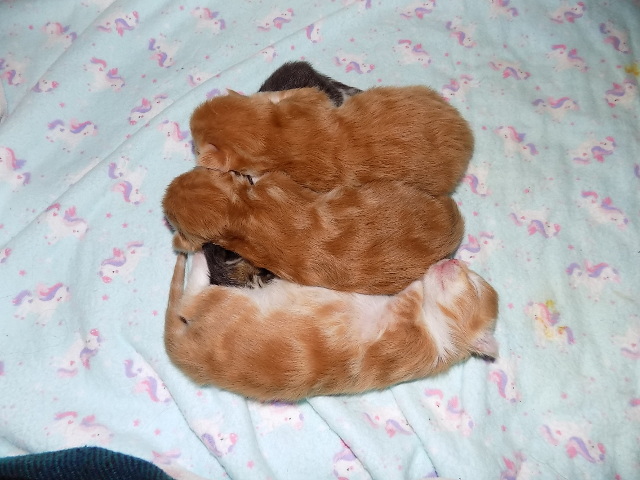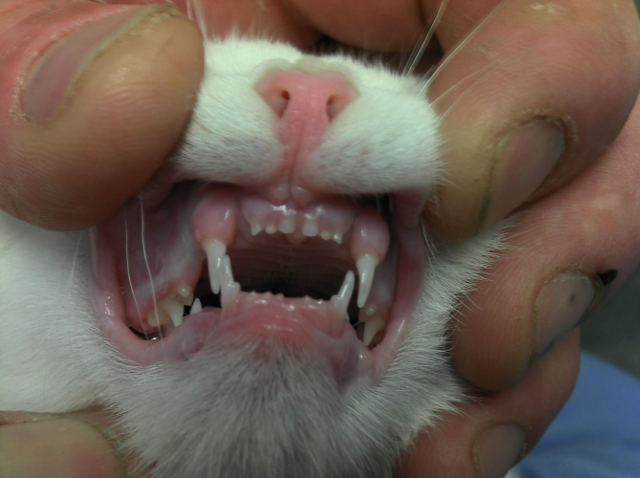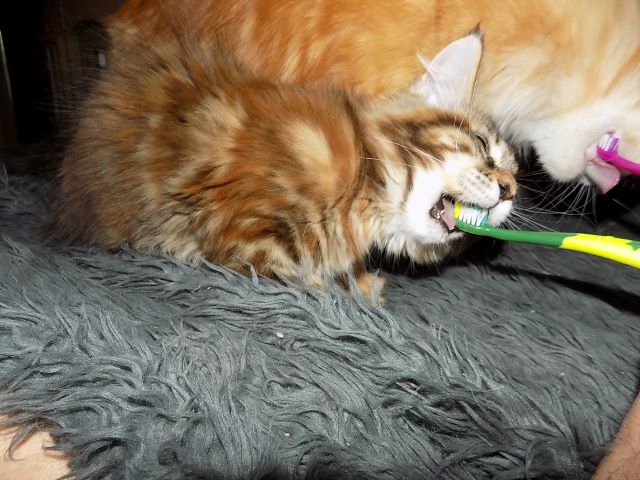Breeding Program: The Beginning
Our Maine Coons are registered with the Canadian Cat Association and are first shown as kittens to be judged as meeting all the requirements of breed standards. It is during the show circuit that we are able to observe his/her temperament and overall demeanor. We are looking for robust kittens having a tolerance to change and the ability to assimilate a previously unknown environment. By the time our breeding kitten(s) have attained Champion status at 8 months of age they are "The Quintessential Cat." Our kitten breeding program begins with mating pairs that share a set of healthy attributes that Minoos regards both as minimum requirements for our bloodline, and the criteria to act as control group for subsequent litter evaluations. Both the sire and dam have medical check-ups, blood screening, and genetic testing performed prior to being considered for our breeding program. Blood tests will indicate that we are mating correct groupings (A,AB) and must come back negative for feline leukemia and feline immunodeficiency virus. DNA testing must have a normal/normal result for hypertrophic cardiomyopathy, spinal muscular atrophy, Polycystic kidney disease, and Pyruvate Kinase Deficiency in Maine Coon Cats. Heart murmurs are not acceptable, not even an innocent or physiologic heart murmur, which is a heart murmur that has no impact on the cat's health. One type of innocent heart murmur is often found in young growing kittens, particularly kittens that are growing rapidly. The murmur may first appear at 6-8 weeks of age, and a kitten with an innocent heart murmur will us ually outgrow it by about 4-5 months of age. This type of murmur is benign. Some normal adult cats may have an intermittent heart murmur that shows up when their heart rate is increased due to stress. This type of physiologic murmur disappears when the heart rate is normal, and has no impact on the cat's health. In general, a physiologic or innocent heart murmur will have a low intensity (usually Grade I-II out of VI), and does not cause any symptoms or clinical signs.
Growth Rate & Immune System
The mating season for the Maine Coon is April and May, with a gestation period of 63-70 days. Litter size is 1 to 5 kittens. We keep our kittens for a minimum of 20 weeks for a number of reasons that the following will explain. A Maine Coon Cat has only one thing in common with other cats and that is being a member of felis silvestris catus, or genetically speaking, having 19 pairs of chromosomes. Other similarities such as growth and maturation do not follow the same course. A domestic cat reaches it's adult weight by about 8 months of age. The Maine Coon doesn't reach its adult weight until he or she is at least 28 months old. The Maine Coon does not finish maturing until she is over 5 years old. Domestic kittens for example, are born weighing 65 to 90 grams. Our babies are born weighing on average 164 grams, however, the fact still remains that the Maine Coon takes a longer period of time to grow. That being said, other maturation issues present themselves such as weaning will not occur until around the 5th or 6th week, and nursing continues forward for at least 4 weeks or more. Weaning is a critical time because the neonates do not have an intact immune system, and their immunity is transfered to them through mothers milk. As they wean they take less of mothers milk as their own immune system slowly begins to come on-line. At 12 weeks of age, a Maine Coon kittens immune system is NOT intact, and our females continue to nurse their babies just past the 14 week mark. By 15 weeks our kittens are reaching what we consider their "safe zone." There are no cages in our home. We have the option of providing five complete and separate cat- friendly environments which include a bathing and grooming facility, two nurseries and one kitten romper room, or to allow the entire house to be open for all our cats to free-roam. The number of these separate environments we employ depends upon the needs of the cattery and it's constituents at any given time. Under strict supervision, we allow breeding cats to eat, play, and groom together as a clowder, or just find a spot on the couch to watch a movie with us. We have strict rules for new in- coming kittens entering our cattery, and a period of quarantine is enforced. Mother and her neonates are confined to their nursery for about 3 to 4 weeks before the kindle is moved to the kitten romper room. By the time kittens are about ten weeks old, Mom will want to start coming out of the kitten room for short periods of time to get re-acquainted with her clowder mates.
Nutrition and Development

Breeding females are on a strict diet of Royal Canin Pro Queen kibble and Royal Canin Baby Cat Mousse. We monitor and record the mother's weight gain from conception to welping. The graph to the right is an example of a female carrying a singlet. Once the babies are born the mother is given calcium supplements twice daily. When the kittens are reaching the 6 to 7 week period, typically weaning time, the mother is fed Royal Canin Pro Baby Cat kibble along with Baby Cat Mousse. As the kittens begin to wean they eat what mom is eating. The Baby Cat Mousse is excellent for both the nutritional quality and the consistency of the food; the kittens suckle their mother for milk, and they begin weaning by suckling at the Mousse on moms plate. After a week or so the kittens are able to bite and chew at the food.

Each kitten is monitored from the moment of birth. Daily average weight gain data is collected and recorded. The graph to the left is an example, and is in fact the singlet born to the mother in the above chart. Individual program plans are implemented for the developing kittens because not all develop physically or mentally at the same rate. It is important that the shy kitten receive the same benefits as his or her litter mates. A kitten that is not quite ready to start climbing a four foot high cat-tree can gain much exercise and confidence with activities involving a few stacked pillows covered over with a blanket. Litter box training is standard, although a bit trying at times, and by about 10 weeks all the kittens are on a level playing field.
The developmental norms for the kitten recorded in this graph is as follows: Kittens are born with their eyes closed and their ears folded. They are blind and deaf; they can only crawl about to navigate the world around them, through scent and by seeking warmth and comfort. They have no teeth, claws are non-retractable, and at present have no gag reflex, nor the ability to thermoregulate (thermoregulation being the ability of an organism to keep its body temperature within certain boundaries, even when the surrounding temperature is very different). Newborns will sleep for the majority of the day. If mother leaves them to "hunt" they will remain huddled in a pile for warmth and comfort. The umbilical cord will be attached and will fall off on its own around 5 to 7 days of age. The birth weight of this particular female Maine Coon was 148 grams.

One-week-old kittens still have eyes closed, however, the umbilical cord will have dried and fallen away. Neonates at this age still have no teeth and claws remain non-retractable. At about 7 days the ear canals will slowly begin to open and the ears will begin to slightly unfold. Between 8 to 12 days the eyes will slowly open, which can occur over several days and one eye may open more quickly than the other. All kittens are born with blue eyes which will transition to an adult eye color with age. Seven day-old kittens, although larger than newborns exhibit movement that is mostly uncoordinated. They still sleep for most of the day, awakening to nurse and to be cleaned by their mother. While awake they are more active, and quite vocal. At this age, they should be able to hold their head up, and move about using a gait with alternating movement of the right and left limbs, similar to a lizard.
At 14 days of age the kitten's eyes will be fully open and the colour blue. Their vision will be poor and they will not be able to see distances. The ear canals are open and the ears will be more upright and heavily furred, with the tuffs drooping somewhat. Teeth are not present and their claws are still non-retractable. Two-week-old kittens are becoming more coordinated and will begin attempting their first steps, with bellies up off the surface. They are wobbly on their feet and unsure with the lifting and placing their paws, as they move in a forward direction.

Kittens at this age will not yet be playing. It should be noted that it has been our experience that play begins almost at the same time that self-grooming has started. Self-grooming will not begin until the kitten exhibits some curiosity for the world around her. Much time is still spent sleeping.
At 21 days of age, the kitten's vision and hearing will be slowly improving, as will the ability to retract their claws. Coordination will be improving rapidly. Also, the kitten's first teeth, their incisors, will begin to emerge through the gums. These are tiny teeth that line up at the front of the upper and lower jaw. Although the picture to the left is of an older kitten, the incisors are quite evident between the upper and lower canines. The incisors are used for cutting and grooming. In fact, the term "comb teeth" has often been used.
At this age, kittens will be walking and sometimes trying to employ a method of short, quick bursts of forward movement which typically result in a face-first collision with the ground. They begin to explore themselves, their surroundings, and even become curious about cat toys. It is at this point that the kittens begin to develop self-grooming behaviors. It should also be noted that although the kitten takes interest in a toy, they have no conception of looking above their immediate field of vision. They have no concept or understanding of object permanence. We use the term object permanence to describe a kitten's ability to know that objects continue to exist even though it can no longer be seen or heard. At this stage of cognitive development, if there is an object directly in front of the kitten's field of vision (an object that the kitten has seen and has focused on) is lifted straight up off the floor the kitten does not know to look up. The kittens have no concept that the world and its objects exist separate from their limited point of view and experience; they are unable to develop a mental representation of the object at this point in their lives. But they will, and become deadly accurate hunters.
Higher Education

The kittens are introduced to a kitty pool of warm water where they learn to splash about and play with water toys. All kittens are bathed about four times before they go to their forever homes. At around 8 weeks of age we begin introducing our kittens to infant tooth brushes so that by the time kittens are 20 weeks old they expect daily dental care with feline toothpaste and their very own tooth brush. During this same time, kittens become accustomed to wearing a harness so that trips involving a pet carrier has an extra safety factor; a harness and lead gives the ultimate in secure handling out of cage and home. We drive our older Coon kittens to the pet store for food, take them into the bank and go through drive- thru's etc. Kittens play with our German Shepherd Celeste while also having supervised run of the house, and they will spend a lot of time with their grandparents as well. We have at the least, 12 generations of our bloodlines living with us, and these older felids teach the young ones about tolerance levels and how to read feline body language. All this aides to socialize our kittens before they go to their forever homes.
Core Vaccinations
Over the years we have monitored and adjusted the vaccinations our kittens receive. The kittens used to have the classic 8 week vaccination with the follow-up 12 and 16 week boosters. One kitten from each litter would then have a titre test performed and the result considered as a sampling from the the group. The titre is to verify that the vaccinations produced the required levels of immunity. In 2017 we started to see lower immune results from the vaccines being used at that time. An extra booster had to be given to correct this issue, but subsequent litters were not responding quite as hoped. The pharmaceutical company that produced the vaccines we used were wonderful, and supplied additional boosters and also provided possible answers as to why the product was not as effective with our cats. One line of reasoning was that the vaccines produced for domestic felines may not be as effective on Maine Coons, because they are in fact a natural breed and are found in the wild. As we endeavour to maintain our breeding as close to foundation as possible, it would stand to reason that this argument is valid. More likely is the fact that many of our kittens are still nursing somewhat at 14 weeks of age, and the antibodies in the mother's milk interfere with the kittens responses to vaccines. Moving ahead, we decided on a vaccine and vaccination regime employed by many zoos for their big cat cubs. We use Boehringer Ingelheim Purevax Feline 4 with the first inoculation at 10 weeks of age, followed by boosters at 14 weeks, 17 weeks, and the final booster at 20 weeks of age. Titre testing a kitten at 8 to 12 months of age after using this method has produced the desired results.
Further medical attention given our kittens includes deworming using Fenbendazole, and the kittens are given their rabies shot at the age of 22 weeks, before they are homed. Rabies vaccinations are given for two reasons; One, it is Ontario law that an initial rabies vaccination be given and two, we show at least one kitten from every litter and it is a requirement for all show halls. For felines that will be travelling across the border or Internationaly, proof of rabies immunity will be required. This is best done with a titre test result or the animals health record indicating a current rabies vaccination. We do not participate in early spay/neuter programs as this is not in the kittens best interests. We ask adopting families that their female kitten(s) be spayed before their third heat cycle (approximately 8 to 12 months of age), and males be kept intact as long as possible. Hopefully for the boys, this would be 12 to 18 months of age.